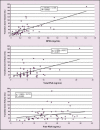Beyond prostate-specific antigen: new serologic biomarkers for improved diagnosis and management of prostate cancer
- PMID: 16985579
- PMCID: PMC1472815
Beyond prostate-specific antigen: new serologic biomarkers for improved diagnosis and management of prostate cancer
Abstract
The use of total prostate-specific antigen (tPSA) measurement has dramatically improved the ability to detect prostate cancer at earlier stages. However, as the number of men presenting with advanced disease (and high tPSA levels) has decreased, and given the fact that tPSA is highly reflective of benign prostatic hyperplasia, the need has emerged for novel biomarkers specifically associated with prostate cancer in order to improve predictive models. Several new biomarkers have shown promise, and studies continue to investigate the role of these markers in the detection, staging, and prognosis of prostate cancer. As new useful biomarkers continue to emerge, guidelines for their employment, as well as coordination of further research studies, are needed; a systematic, phased, nomogram-based model is a rational way to manage these efforts.
Figures







References
-
- Darson MF, Pacelli A, Roche P, et al. Human glandular kallikrein 2 (hK2) expression in prostatic intraepithelial neoplasia and adenocarcinoma: a novel prostate cancer marker. Urology. 1997;49:857–862. - PubMed
-
- Aihara M, Lebovitz RM, Wheeler TM, et al. Prostate specific antigen and gleason grade: an immunohistochemical study of prostate cancer. J Urol. 1994;151:1558–1564. - PubMed
-
- Babaian RJ, Fritsche HA, Evans RB. Prostate-specific antigen and prostate gland volume: correlation and clinical application. J Clin Lab Anal. 1990;4:135–137. - PubMed
-
- Kane RA, Littrup PJ, Babaian R, et al. Prostate-specific antigen levels in 1695 men without evidence of prostate cancer: findings of the American Cancer Society National Prostate Cancer Detection Project. Cancer. 1992;69:1201–1207. - PubMed
-
- Roehrborn CG, Boyle P, Gould AL, Waldstreicher J. Serum prostate-specific antigen as a predictor of prostate volume in men with benign prostatic hyperplasia. Urology. 1999;53:581–589. - PubMed
LinkOut - more resources
Full Text Sources
Other Literature Sources
Research Materials
